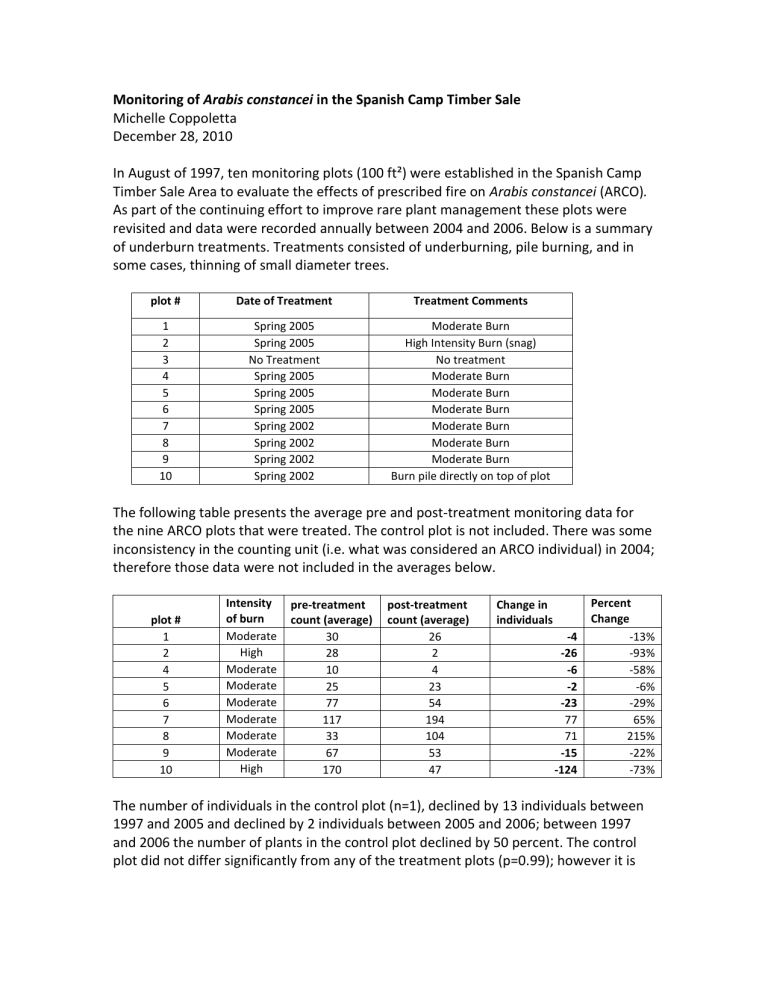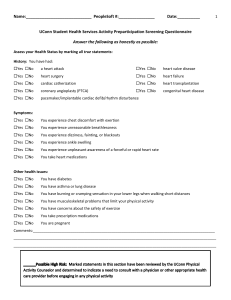Arabis constancei Michelle Coppoletta December 28, 2010

Monitoring of Arabis constancei in the Spanish Camp Timber Sale
Michelle Coppoletta
December 28, 2010
In August of 1997, ten monitoring plots (100 ft²) were established in the Spanish Camp
Timber Sale Area to evaluate the effects of prescribed fire on Arabis constancei (ARCO) .
As part of the continuing effort to improve rare plant management these plots were revisited and data were recorded annually between 2004 and 2006. Below is a summary of underburn treatments. Treatments consisted of underburning, pile burning, and in some cases, thinning of small diameter trees. plot # Date of Treatment Treatment Comments
1
2
3
4
5
6
7
8
9
10
Spring 2005
Spring 2005
No Treatment
Spring 2005
Spring 2005
Spring 2005
Spring 2002
Spring 2002
Spring 2002
Spring 2002
Moderate Burn
High Intensity Burn (snag)
No treatment
Moderate Burn
Moderate Burn
Moderate Burn
Moderate Burn
Moderate Burn
Moderate Burn
Burn pile directly on top of plot
The following table presents the average pre and post-treatment monitoring data for the nine ARCO plots that were treated. The control plot is not included. There was some inconsistency in the counting unit (i.e. what was considered an ARCO individual) in 2004; therefore those data were not included in the averages below. plot #
Intensity of burn pre-treatment count (average) post-treatment count (average)
Change in individuals
1 Moderate 30 26 -4
Percent
Change
-13%
2
4
5
6
7
8
9
High
Moderate
Moderate
Moderate
Moderate
Moderate
Moderate
28
10
25
77
117
33
67
2
4
23
54
194
104
53
-26
-6
-2
-23
77
71
-15
-93%
-58%
-6%
-29%
65%
215%
-22%
10 High 170 47 -124 -73%
The number of individuals in the control plot (n=1), declined by 13 individuals between
1997 and 2005 and declined by 2 individuals between 2005 and 2006; between 1997 and 2006 the number of plants in the control plot declined by 50 percent. The control plot did not differ significantly from any of the treatment plots (p=0.99); however it is
important to note that the single control plot did not afford much experimental power
(0.05).
Two of the plots were classified as “high intensity” treatments due to a burn pile that was placed directly on top of the plot (#10) and a large snag that fell into the plot while burning (#2). The remaining plots were classified as “low to moderate intensity” due to the fact that there were very little fuels present (i.e. rocky, serpentine habitat) and no evidence of high intensity burning was seen post-treatment.
A comparison of these two treatment types - high intensity (n=2) and low to moderate intensity (n=7) - showed a significant difference (p=0.04) between the two treatment types in terms of the percent change (i.e. change in the number of individuals before and after treatment). Those plots that experienced a higher intensity treatment decreased on average by 60 percent. In contrast, those plots that had a more moderate intensity treatment increased by an average of 22 percent. These results suggest that
ARCO is intolerant of high intensity fire (i.e. burning a pile directly on top of plants).
Treatment Type
High Intensity Plots (n=2)
Average change (post-pre/post) in number of individuals following treatment
-60%
Low to Moderate Intensity Plots
(n=7)
+ 22%
* Note: values were transformed (ArcSIN) for the analysis in order to meet the assumption of normality.
Management Implications
Overall, the data from these plots suggest that ARCO is tolerant of low to moderate intensity underburning treatments and intolerant of high intensity fire.





